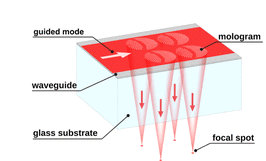Focal Molography
Focal Molography uses a laser beam to detect biomolecules bound to the active line on the surface which is diffracted into a focal point below the chip and is measured.
A mologram is a biological diffractive element fabricated using biomolecules and nanolithography approaches.
molecules + hologram = mologram
Focal molography combines state-of-the-art lithography, molecular self-assembly, and optical technology into one powerful technique. The technique allows biospecific molecular binding to be observed by cleverly exploiting the weak diffraction of light by a coherent pattern of molecules (or nanoparticles). Molecules that bind nonspecifically to the sensor surface contribute only incoherently to the sensor signal, and the coherent signal from analyte molecules on the sensor surface is much stronger than the signal from molecules that contribute incoherently. The focal molography method has two unique advantages in comparison with existing molecular sensing methods: (i) it eliminates the effect of nonbiospecific binding, which is the limiting factor in all current state-of-the-art molecular sensing devices, and (ii) it has a very high sensitivity that can be amplified by increasing the size of the sensor.


MACS® Matchmaker
The first commercial instrument using focal Molography, revolutionizes biological interaction measurement. This innovative approach provides a direct, undisturbed view of molecular dynamics in their natural state in the native environment, without the need for labels, overcoming traditional research limitations like signal disturbance and non-specific binding. The MACS® Matchmaker comes with the following unique features:
- Label-free measurements in crude media: in vivo-like environment and eliminate the hassle of pre-purification saving time.
- Simple assay development: Leverage our easy-to-use sensor functionalization protocol to set up your experiments faster than ever.
- Multiplexing for increased speed: Characterize 54 interactions simultaneously, significantly reducing experiment times.
- Assay automatization: Use the MACS® Sampler for fully unattended runs in combination with up to 2 x 384 well plates.
- Drift-free data: Experience robust and more reliable data with minimized artifacts by our patented focal molography technology.
- pM Sensitivity: Characterize even small proteins or peptides in complex biological matrices.
- Data availability: Control of your data at all time from any place by our platform independent software solutions.
More information at the website op lino Biotech AG.
